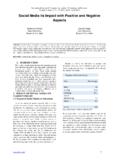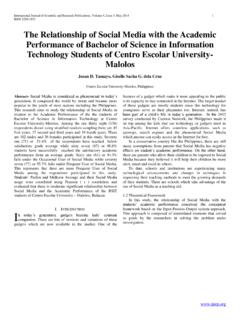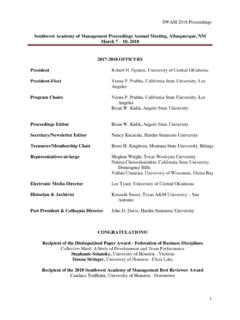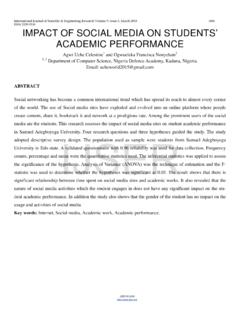Transcription of Gender dominated industries: Breaking through the glass ...
1 Journal of Academic and Business Ethics Gender dominated industries: Breaking through the glass ceiling Yusimit Barrios Carlos Albizu University Toni DiDona Carlos Albizu University ABSTRACT. Previous research suggests that Gender compositions have different effects on men and women in the workplace. Social norms regarding Gender roles have a potential to create bias evaluations of individuals who violate their particular accepted Gender role. This bias can affect the individual in a way that causes them to experience work stressors that may affect their performance. This study explores the differences between the type of stressors nontraditional men and women may experience based on their Gender , providing a glimpse of the bridging gap between male and female dominated industries.
2 Men in nursing were compared with women in construction based on their responses to the Workplace Stressor Assessment Questionnaire (WSAQ) developed and validated by professionals from Critical Path Institute which measures categories of work stressors. A. one-way between subjects ANOVA was conducted to compare the effect of Gender on workplace stressors in different categories of stressors: Demands, Control, Support, Role, Relationships, and Rewards on the conditions of either male- dominated industry (construction) or female dominated industry (nursing). There was a significant effect of IV. Gender on DV workplace stressors at the p<.05 level for the Demands stressors [F (3,105) =. , p = ], Control Stressors [F (3,105) = , p = ], Support Stressors [F. (3,105) = , p = ], and Role Stressors [F (3,105) = , p = ].
3 Keywords: Gender , sex-role, occupation, conflict, job satisfaction Copyright statement: Authors retain the copyright to the manuscripts published in AABRI. journals. Please see the AABRI Copyright Policy at Gender dominated industries, page 1. Journal of Academic and Business Ethics INTRODUCTION. Taylor (2010) introduces the concept of an occupational minority, defined as a worker who is a numerical rarity in his or her occupation. Examples of occupational minorities include: male nurses, female construction workers, male teachers, and female surgeons. This concept focuses on minorities at the occupational level and does not take into account actual Gender composition of their specific organization. This view involves perceptions of appropriate Gender roles, interactions, and support.
4 It suggests that Gender compositions have different effects on both men and women in the workplace. In accordance with this theory, women are more likely to receive social backlash when successful in a male-dominate occupation (Heilman, Wallen, Fuchs, & Tamkins, 2004). This negative response stems from social norms regarding Gender roles and stereotypes, which has a potential to create bias in evaluations of women in the workplace (Heilman et al., 2004). This bias can lead women to be perceived as having less workplace support than their male counterparts, which can create obstacles in accessing information and gaining assistance in the workplace (Taylor, 2010). Surprisingly, both men and women are prone to see women who violate social Gender norms as not likeable, and both have a tendency for hostility against women who are successful in male- dominated occupations (Taylor, 2010; Heilman et al.)
5 , 2004). Negative evaluations of women may affect certain occupational rewards, such as salaries and promotions (Heilman et al, 2004). Research further suggests that it is not generally the same when the situation is reversed; when men are successful at female- dominated occupations, it does not produce social disapproval and when it does, it is of benefit to them (Heilman et al., 2004). Current literature illustrates, for example, women in male- dominated industries are seen as less competent in their occupation when expressing stereotypical femininity. However, when expressing a stereotypically masculine leadership style, women are viewed as successful but not well liked by their peers (Bergman, 2008). Women in these industries seem to have the choice of conforming to unpopularity or viewed as incapable of performing their duties.
6 Men in female- dominated industries face a different dilemma, to the extent that because co-workers or supervisors may feel that they are violating social norms, they are pushed into higher leadership type positions that are more in line with male Gender roles ( , Director of Nursing) (Taylor, 2010). This process, labeled as access and treatment discrimination (Mclean & Kalin, 1994), occur when women and men are selected by employers into Gender -traditional occupations, and include as well exclusion from Gender - nontraditional occupations. Furthermore, another form of this type of discrimination is evident in the formation of network ties in which women in male- dominated industries are at a disadvantage in the creation of these ties because in order to establish networking opportunities, one would need to express similar interests and characteristics to the target population.
7 This is difficult for women to reach out to their male supervisors whom they do not express shared interests. Men, on the other hand, do share interests with their same-sex supervisors and therefore have more resources available to obtain assistance/information than their female counterparts (Taylor, 2010). A 1999 study conducted by Graham & Welbourne found that women have a higher pay satisfaction compared to men, despite women's pay rate being significantly less than men. Additionally, women generally tend to have lower expectations on what they are worth compared to men (Major & Konar, 1984). This lower expectation is assumed to be a result of feelings of alienation and inadequacy in the workplace which stems from the inability of women to receive social support in their male- dominated industry (Bergman, 2008).
8 As a Gender dominated industries, page 2. Journal of Academic and Business Ethics result, women may feel less compelled to seek or ask for promotions and/or pay raises which further hinder their ability to advance in their careers leading to the creation of the glass ceiling effect (Cotter, Hermsen, Ovadia, & Vanneman, 2001). The glass ceiling effect refers to the phenomenon of women receiving a wider gap in earnings and status as they gain more experience compared to their male counterparts (Morgan, 1998). Even those who surpass the glass ceiling still experience less authority and fewer benefits compared to their male counterparts (Zhang, Schmader, & Forbes, 2009). In another study conducted regarding Gender gap concerning garnishments, it was reported that women choose to stay in occupations that are compatible with female Gender stereotypes because they earn more than in a male- dominated occupation (Gabriel & Schmitz, 2006).
9 For example, if they were to pursue a career in a male- dominated occupation they would more than likely only receive two-thirds of the pay rate of men in the same industry (Gabriel & Schmitz, 2006). Apart from these consequences, there are three other factors on how the minority status may have adverse effects on individuals (Mastekaasa, 2004). The first is visibility, in which the minority will stand out in contrast, receiving more attention which can lead to higher performance pressure. The second is assimilation, in where a minority member is perceived as a representative of their category and therefore more subject to stereotyping. The third is polarization, in which the presence of minority members is in sharp contrast to the similarities between the members of the majority (Mastekaasa, 2004).
10 These factors can cause increase in work stressors, add negative effects in health, and decreases motivation which can result in negative evaluations further hindering the minority and adding to the stereotype (Mastekaasa, 2004). Also to consider is Gender differences in family-work conflict. Family-work conflict is a source of stress that can affect an individual's work productivity, emotional and physical well being, as well as parenting performance (Duxbury & Higgins, 1991). Even though more women are working full time and there is a sharp increase in dual earning couples today, society still holds traditional Gender specific perceptions of work and family responsibilities (Duxbury & Higgins, 1991). This view can create a unique stress for women who are compelled to balance work and family life effectively, almost to impossible standards.













